Paste Backfilling Longwall Mining Technology for Thick Coal Seam Extraction under Buildings and above Confined Aquifers: A Case Study
Abstract
:1. Introduction
2. Engineering Background
3. Failure Analysis of Floor Water Inrush and Surrounding Rock by the Longwall Caving Method
3.1. Theoretical Analysis of the Failure of the Floor and Surrounding Rock by the Longwall Caving Method
- aa’b(Ⅰ), Active limit region. abc(Ⅱ),Transition region. acd(Ⅲ)Passive limit region.
- r, The distance from a to bc, m. θ, The included angle between r and ab, °.
- ϕ0, Angle of friction in floor strata, °. e, Maximum depth point of floor failure.
- h1, Maximum failure height of floor, m. L1, Horizontal distance between the maximum failure height of bottom plate and the end of working face, m. L2, Maximum length of floor rock mass failure zone along horizontal direction, m. γ, Mean volumetric forces of overlying strata.
- H, The depth of a cell from the surface, m. m, n, Stress coefficient. xa, Plastic zone width, m.
3.2. Numerical Simulation of Floor and Surrounding Rock Failure by Longwall Caving Method
3.3. Longwall Caving Method Physical Simulation
- (1)
- Model geometric similarity coefficient (geometric similarity ratio)
- (2)
- Time similarity coefficient (time similarity ratio)
- (3)
- Unit weight similarity coefficient (unit weight similarity ratio)
- (4)
- Similarity coefficient of other mechanical parameters (similarity ratio of other mechanical parameters)
- Strength ratio: .
- External force ratio:
- Elastic modulus ratio:
- Poisson’s ratio:
4. Analysis of Water Inrush Safety and Surrounding Rock Failure of the Backfill Method
4.1. Theoretical Analysis of the Failure of the Backfill Floor and Surrounding Rock
4.2. Numerical Simulation of the Failure of Backfill Floor and Surrounding Rock
5. Engineering Case Analysis
6. Conclusions
- (1)
- The characteristics of floor water inrush at the working face 32,021 of the Liangbei coal mine were studied under different caving and filling methods. The water inrush coefficient of the caving method was greater than the regional critical water inrush coefficient, which is dangerous for water inrush. In contrast, the filling method coefficient was less than the critical water inrush coefficient. The relationship between the water inrush coefficient and the filling rate was established. The floor’s failure depth and the water inrush coefficient of the filling method were significantly reduced, compared with the longwall caving method. Thereby, this can ensure the safe mining of the working face. The minimum filling rate to ensure the safe mining of the working face was given;
- (2)
- The longwall caving mining method had the risk of water inrush. Many strata and cracks appeared in the roof of the working face. During working face propulsion, stepped dislocation connected with fracture zone advancement occurs, which influences the surface. Under the conditions of filling mining, the failure depth of the working face floor, the width of the plastic zone, the displacement subsidence value of the overburden, and the vertical stress values were greater. Moreover, the wall caving mining was significantly reduced, which was negatively correlated with the strength of the filling body. Backfill effectively reduced overburden stress and transferred stress concentration. Through comparative analysis, it was determined that the strength of the filling body was 3 MPa;
- (3)
- The maximum values of horizontal deformation, tilt deformation, and subsidence were 1.1 mm/m, 2.5 mm/m, and 730 m, respectively. These values were within the allowable deformation range of the building and were consistent with the measured results from the surface; therefore, these can be used to protect surface buildings.
Author Contributions
Funding
Data Availability Statement
Acknowledgments
Conflicts of Interest
References
- Xu, J.L.; Xuan, D.Y.; Zhu, W.B.; Wang, X. Partial backfilling coal mining technology based on key strata control. J. Min. Strata Control Eng. 2019, 1, 69–76. [Google Scholar]
- Lu, H.F.; Yao, D.X.; Hu, Y.B.; Sun, J. Elasticity solution for failure depth of mining floor under water pressure. J. Min. Saf. Eng. 2017, 34, 452–458. [Google Scholar]
- Luo, L.P.; Peng, S.P. Mechanism study on water-inrush hazard of floor strata in mining on confined aquifer. J. China Coal Soc. 2005, 30, 459–462. [Google Scholar]
- Gui, H.R.; Lin, M.L. Types of water hazards in China coalmines and regional characteristics. Nat. Hazards 2016, 84, 1501–1512. [Google Scholar] [CrossRef]
- Li, X.S.; Yang, W.B.; Wang, Y.M.; Nie, W.; Liu, Z.F. Macro-micro response characteristics of surrounding rock and overlying strata towards the transition from open pit to underground mining. Geofluids 2021, 2021, 5582218. [Google Scholar] [CrossRef]
- Guo, W.B.; Zhao, G.B.; Bai, E.H.; Guo, M.; Wang, Y. Effect of overburden bending deformation and alluvium mechanical parameters on surface subsidence due to longwall mining. Bull. Eng. Geol. Environ. 2021, 80, 2751–2764. [Google Scholar] [CrossRef]
- Zhou, H.Q.; Hou, C.J.; Sun, X.K.; Qu, Q.; Chen, D. Solid waste paste filling for None-Village-Relocation coal mining. J. China Univ. Min. Technol. 2004, 33, 30–34. [Google Scholar]
- Ma, D.; Kong, S.B.; Li, Z.H.; Zhang, Q.; Wang, Z.H.; Zhou, Z.L. Effect of wetting drying cycle on hydraulic and mechanical properties of cemented paste backfill of the recycled solid wastes. Chemosphere 2021, 280, 131163. [Google Scholar] [CrossRef]
- Ke, X.; Zhou, X.; Wang, X.S.; Wang, T.; Hou, H.B.; Zhou, M. Effect of tailings fineness on the pore structure development of cemented paste backfill. Constr. Build. Mater. 2016, 126, 345–350. [Google Scholar] [CrossRef]
- Li, M.; Zhang, J.X.; Huang, Y.L.; Zhou, N. Effects of particle size of crushed gangue backfill materials on surface subsidence and its application under buildings. Environ. Earth Sci. 2017, 76, 603. [Google Scholar] [CrossRef]
- Jirina, T.; Jan, S. Reduction of surface subsidence risk by fly ash exploitation as filling material in deep mining areas. Nat. Hazards. 2010, 53, 251–258. [Google Scholar] [CrossRef]
- Bai, E.H.; Guo, W.B.; Tan, Y.; Huang, G.S.; Guo, M.J.; Ma, Z.B. Roadway backfill mining with super-high-water material to protect surface buildings: A case study. Appl. Sci. 2020, 10, 107. [Google Scholar] [CrossRef] [Green Version]
- Wang, X.F.; Zhang, D.S.; Sun, C.D.; Wang, Y. Surface subsidence control during bag filling mining of super high-water content material in the Handan mining area. Int. J. Oil Gas Coal Technol. 2016, 13, 87–102. [Google Scholar] [CrossRef]
- Doherty, J.P.; Hasan, A.; Suazo, G.H.; Fourie, A. Investigation of some controllable factors that impact the stress state in cemented paste backfill. Can. Geotech. J. 2015, 52, 1901–1912. [Google Scholar] [CrossRef]
- Behera, S.K.; Mishra, D.P.; Singh, P.; Mishra, K.; Mandal, S.K.; Ghosh, C.N.; Kumar, R.; Mandal, P.K. Utilization of mill tailings, fly ash and slag as mine paste backfill material: Review and future perspective. Constr. Build. Mater. 2021, 309, 125120. [Google Scholar] [CrossRef]
- Jafari, M.; Grabinsky, M. Effect of hydration on failure surface evolution of low sulfide content cemented paste backfill. Int. J. Rock Mech. Min. Sci. 2021, 144, 104749. [Google Scholar] [CrossRef]
- Jafari, M.; Shahsavari, M.; Grabinsky, M. Experimental study of the behavior of cemented paste backfill under high isotropic compression. J. Geotech. Geoenviron. Eng. 2020, 146, 06020019. [Google Scholar] [CrossRef]
- Chang, Q.L.; Sun, X.K.; Dong, X.J.; Shao, S. Stability analysis of cemented paste backfill false roof in highwall mining: A case study. Desalin. Water Treat. 2021, 219, 96–102. [Google Scholar] [CrossRef]
- Fall, M.; Adrien, D.; Celestin, J.C.; Pokharel, M.; Toure, M. Saturated hydraulic conductivity of cemented paste backfill. Miner. Eng. 2009, 22, 1307–1317. [Google Scholar] [CrossRef]
- Chen, S.J.; Du, Z.W.; Zhang, Z.; Zhang, H.; Xia, Z.; Feng, F. Effects of chloride on the early mechanical properties and microstructure of gangue-cemented paste backfill. Constr. Build. Mater. 2020, 235, 117504. [Google Scholar] [CrossRef]
- Liu, S.L.; Liu, W.T.; Shen, J.J. Stress evolution law and failure characteristics of mining floor rock mass above confined water. KSCE J. Civ. Eng. 2017, 21, 2665–2672. [Google Scholar] [CrossRef]
- Sun, J.; Hu, Y.; Zhao, G.M. Relationship between water inrush from coal seam floors and main roof weighting. Int. J. Min. Sci. Technol. 2017, 27, 873–881. [Google Scholar] [CrossRef]
- Wu, Q.; Liu, Y.Z.; Liu, D.H. Prediction of floor water inrush: The application of GIS-Based AHP Vulnerable Index method to Donghuantuo coal mine, China. Rock Mech. Rock Eng. 2011, 44, 591–600. [Google Scholar] [CrossRef]
- Zhu, S.Y.; Jiang, Z.Q.; Zhou, K.J.; Peng, G.; Yang, C. The characteristics of deformation and failure of coal seam floor due to mining in Xinmi coal field in China. Bull. Eng. Geol. Environ. 2014, 73, 1151–1163. [Google Scholar] [CrossRef]
- Yin, H.C.; Xu, B.; Yin, S.X.; Tian, W.; Yao, H.; Meng, H. Prevention of water inrushes in deep coal mining over the Ordovician aquifer: A case study in the Wutongzhuang Coal Mine of China. Geofluids 2021, 2021, 5208670. [Google Scholar] [CrossRef]
- Song, W.C.; Liang, Z.Z. Theoretical and numerical investigations on mining-induced fault activation and groundwater outburst of coal seam floor. Bull. Eng. Geol. Environ. 2021, 80, 5757–5768. [Google Scholar] [CrossRef]
- Zhang, J.C. Investigations of water inrushes from aquifers under coal seams. Int. J. Rock Mech. Min. Sci. 2005, 42, 350–360. [Google Scholar] [CrossRef]
- Yin, S.X.; Zhang, J.C.; Liu, D.M. A study of mine water inrushes by measurements of in situ stress and rock failures. Nat. Hazards 2015, 79, 1961–1979. [Google Scholar] [CrossRef]
- Wang, J.; Fu, J.X.; Song, W.D.; Zhang, Y.F. Viscosity and strength properties of cemented tailings backfill with fly ash and its strength predicted. Minerals 2021, 11, 78. [Google Scholar] [CrossRef]
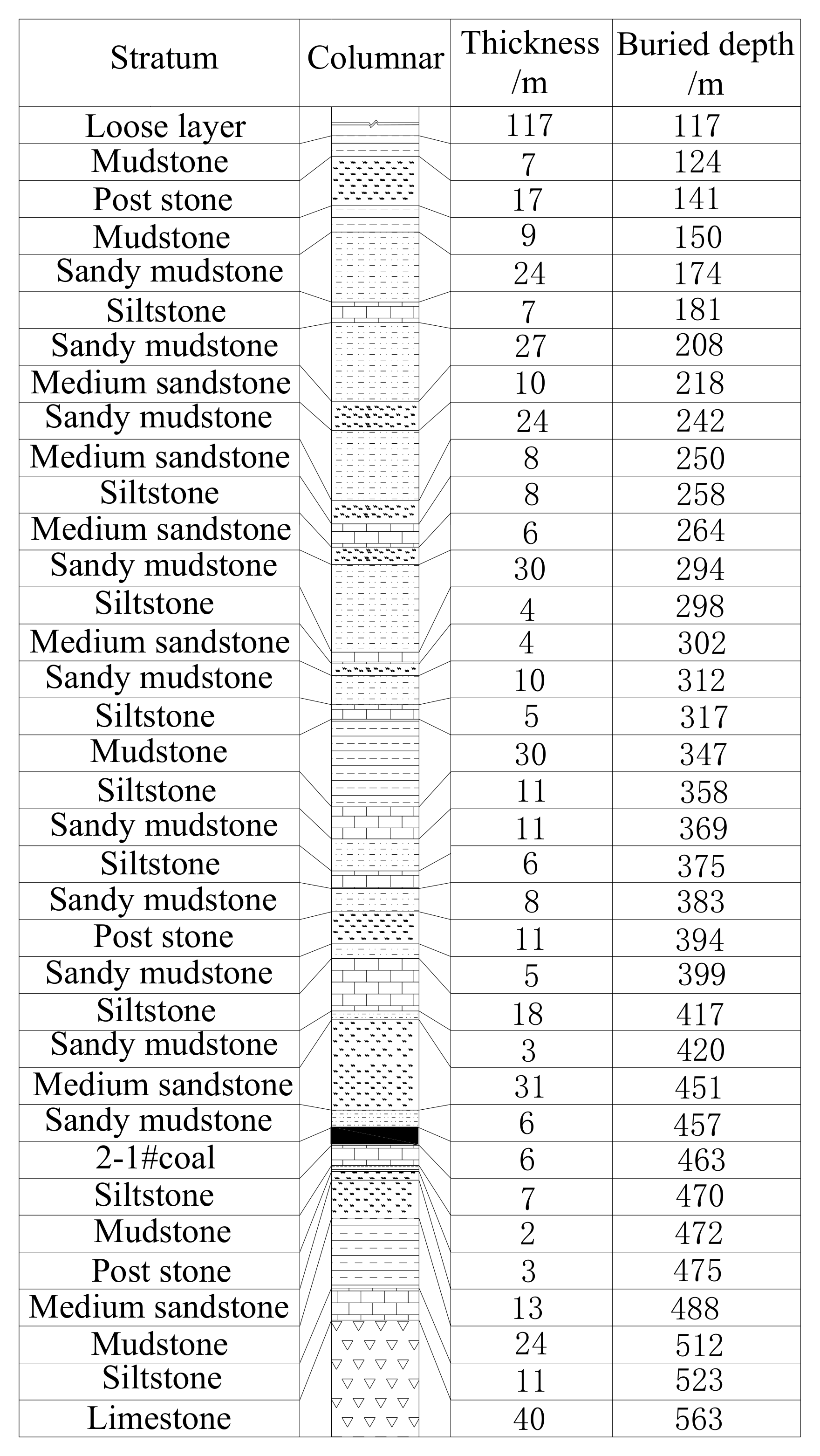
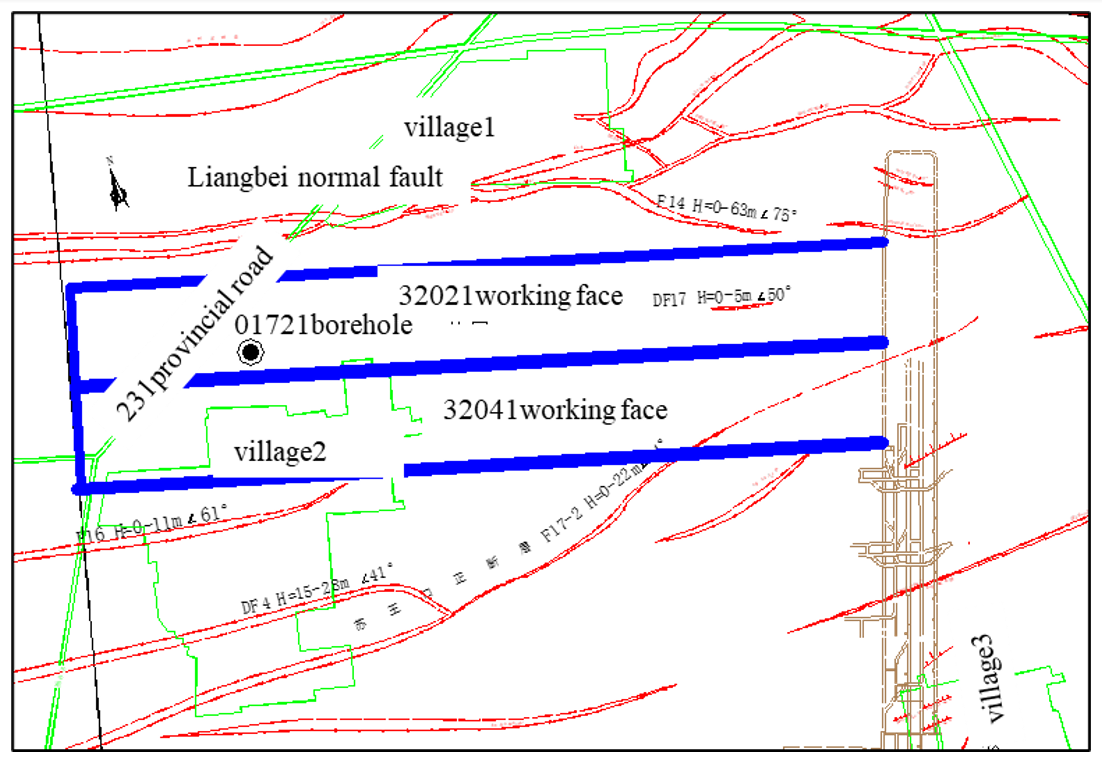
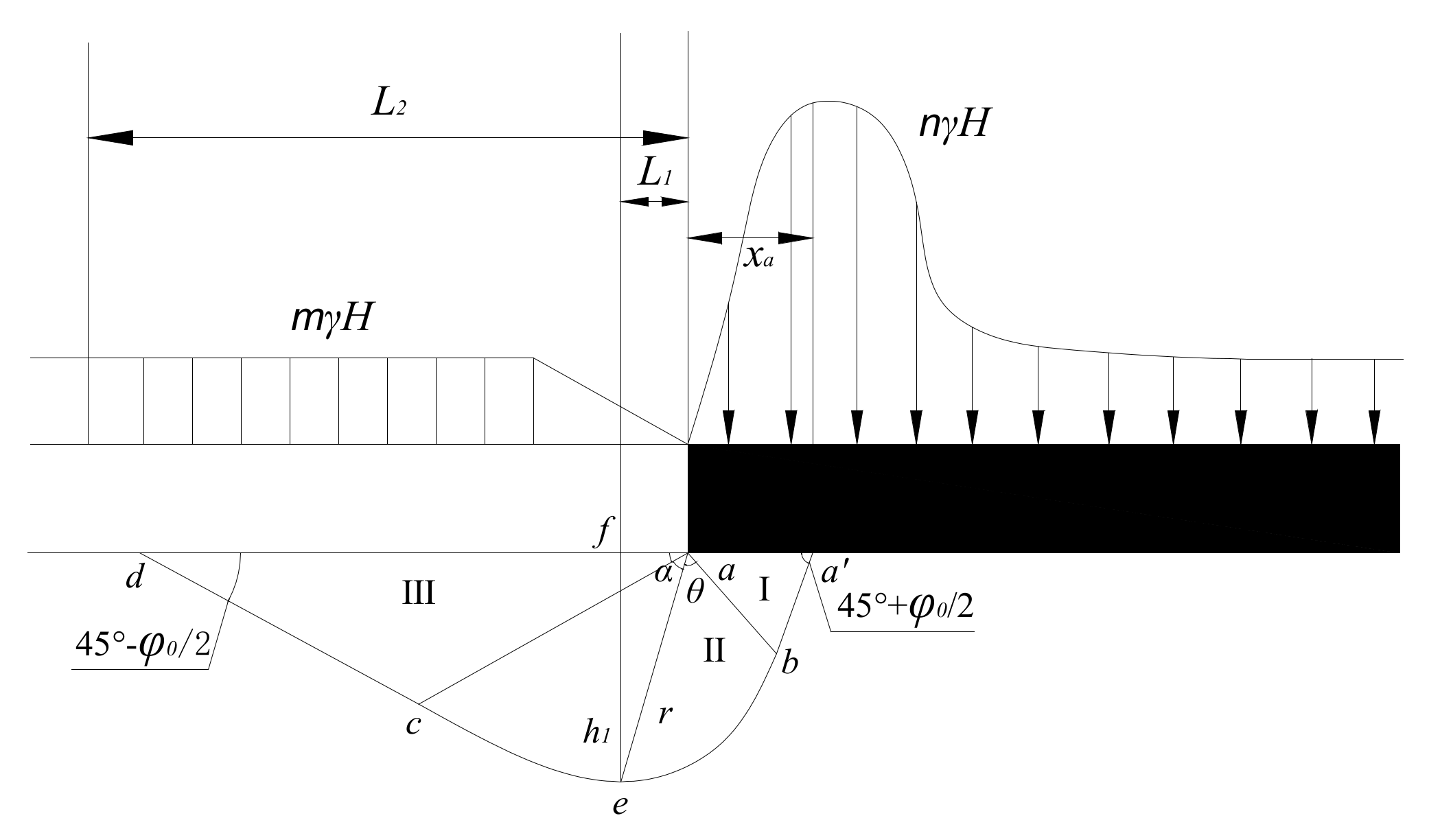
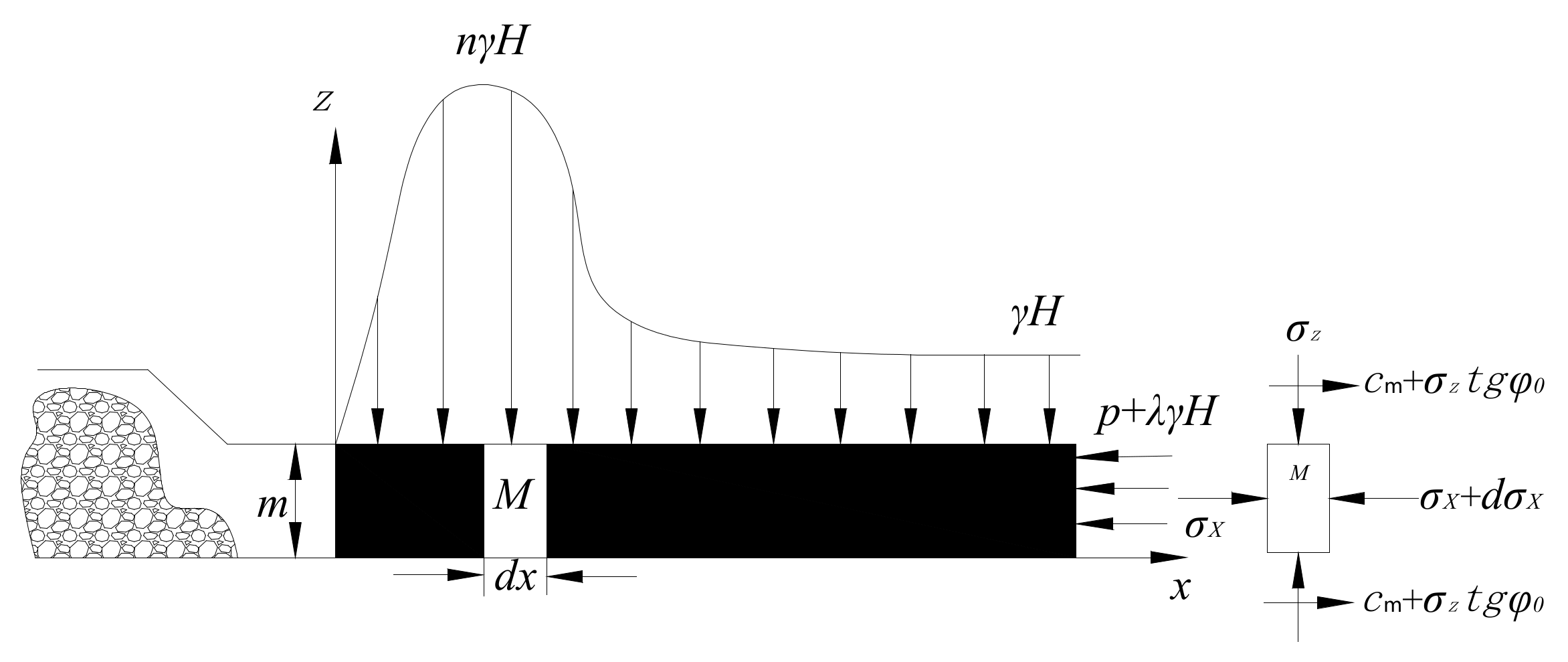

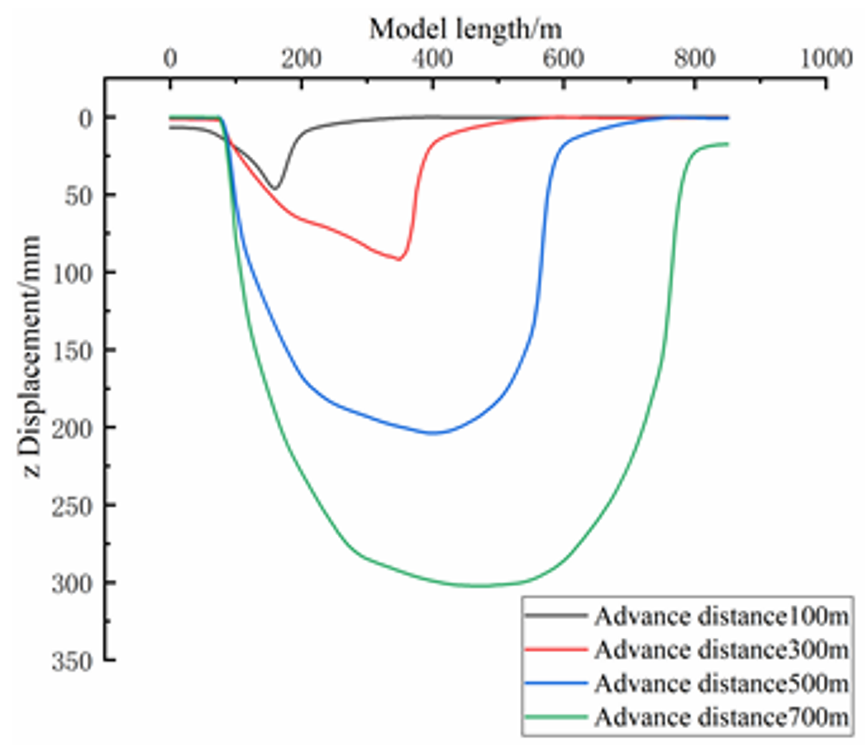
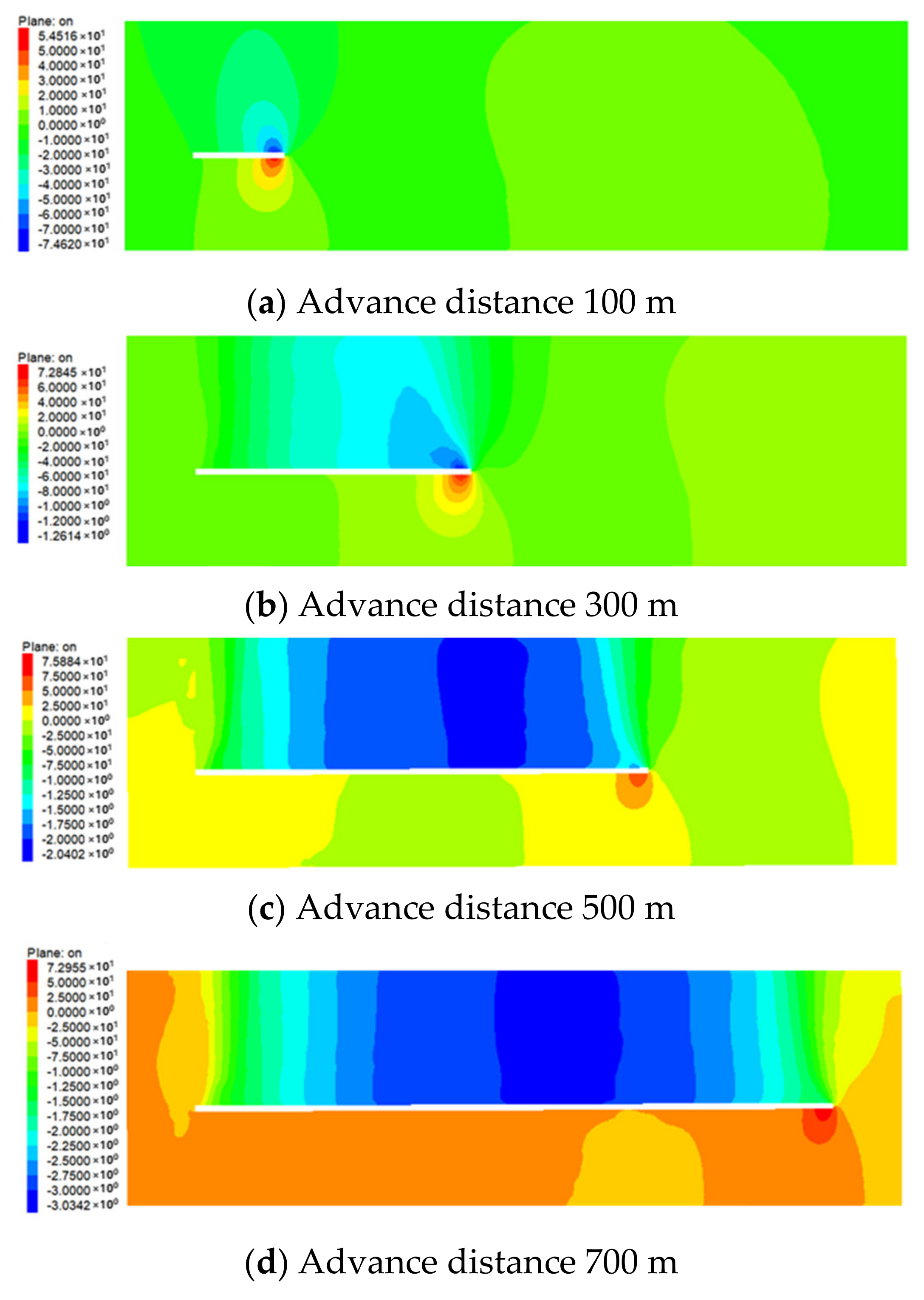
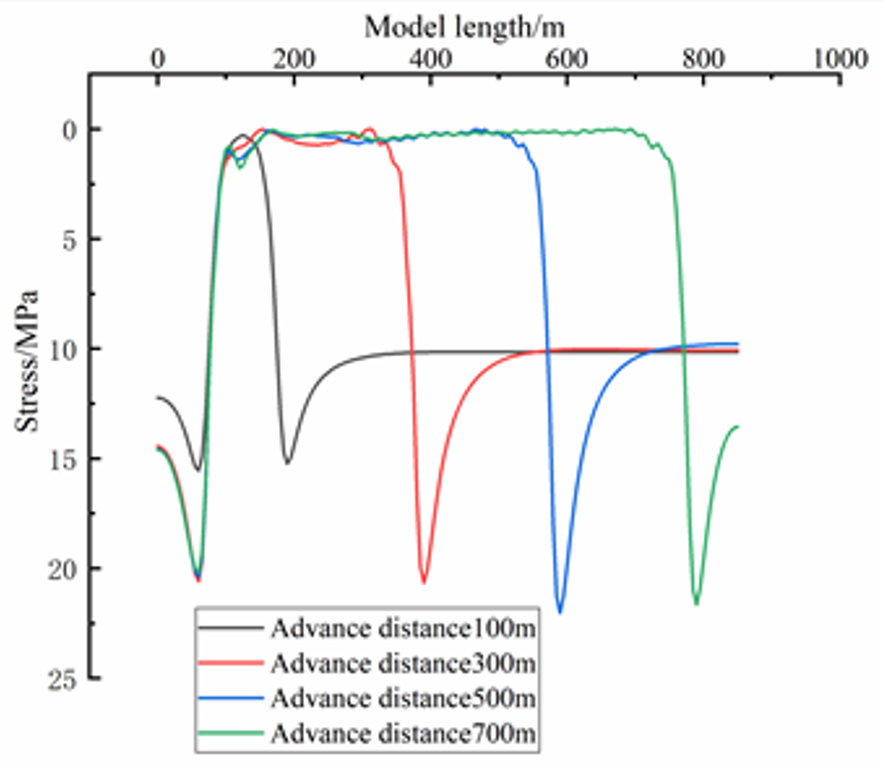

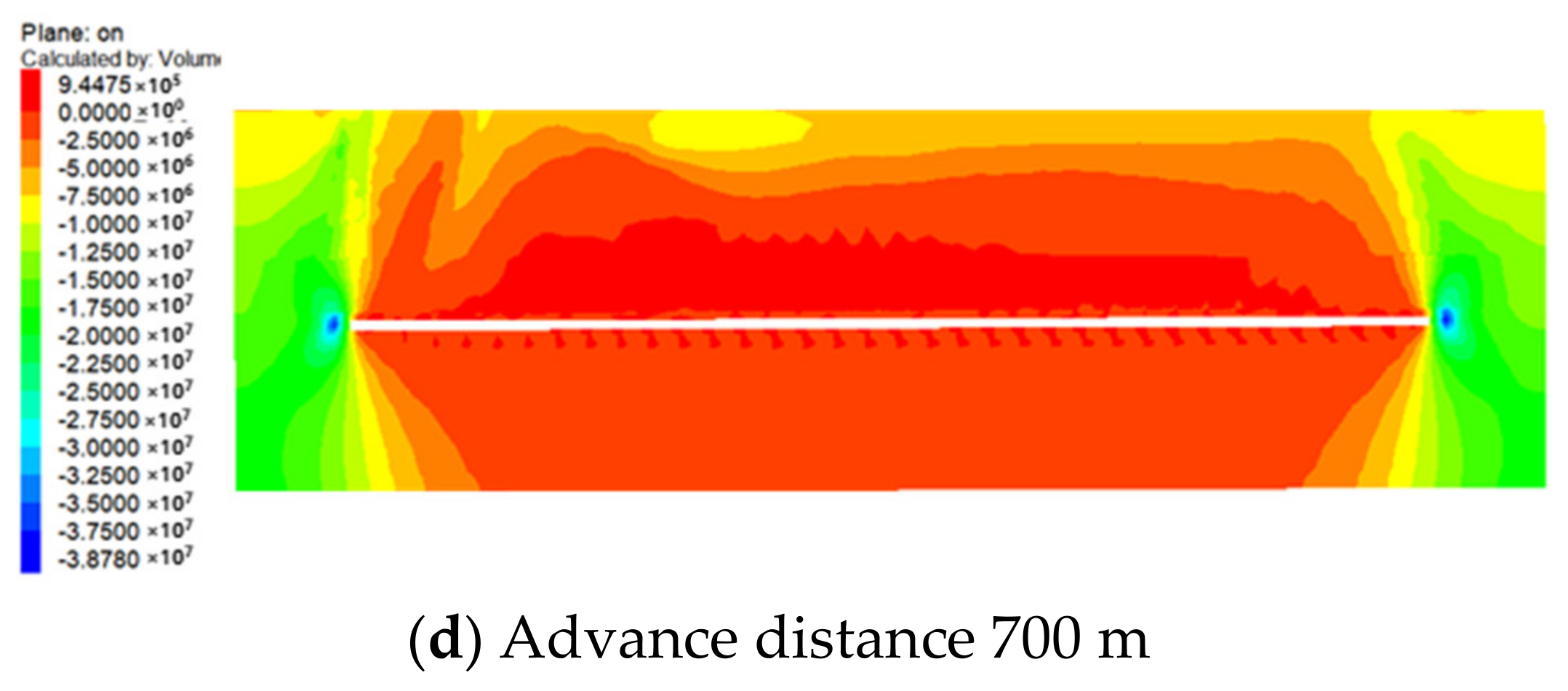
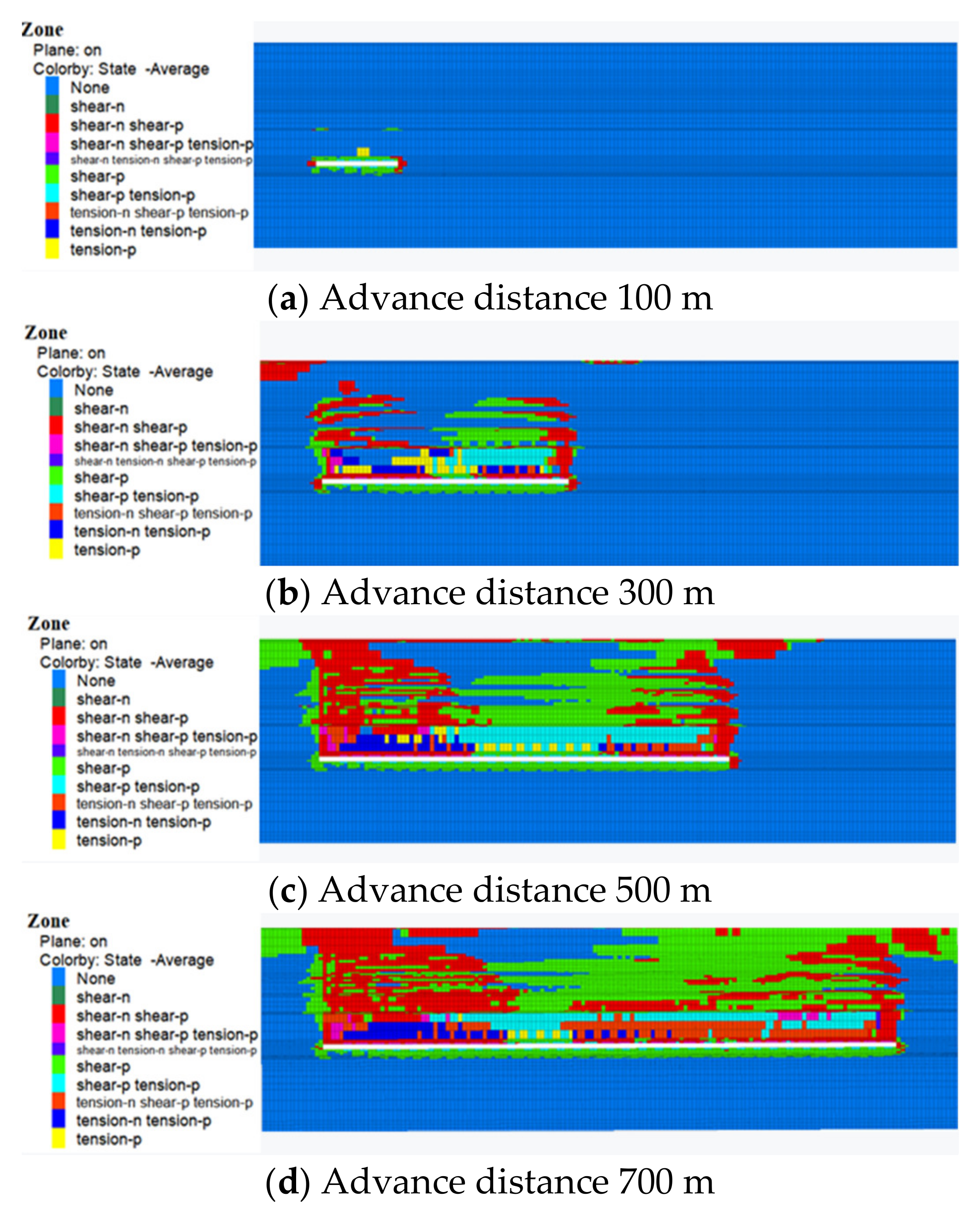



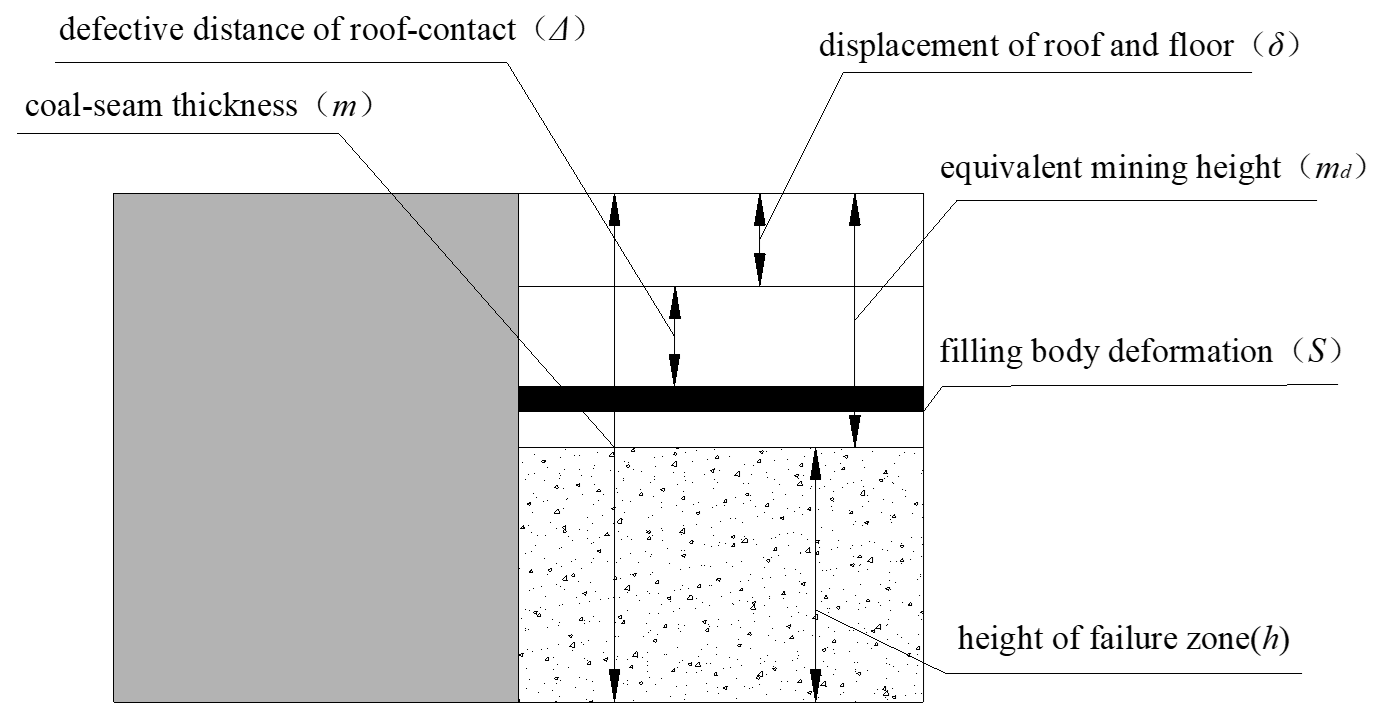


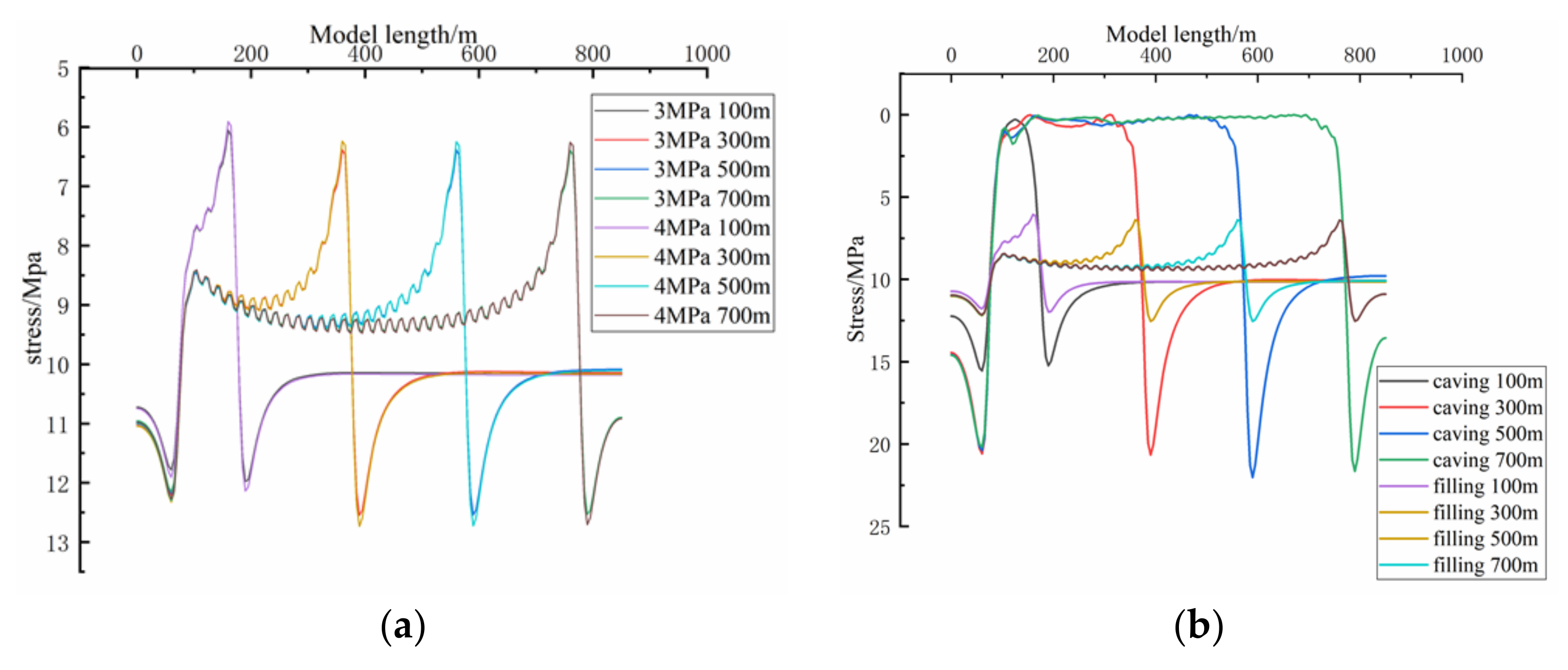
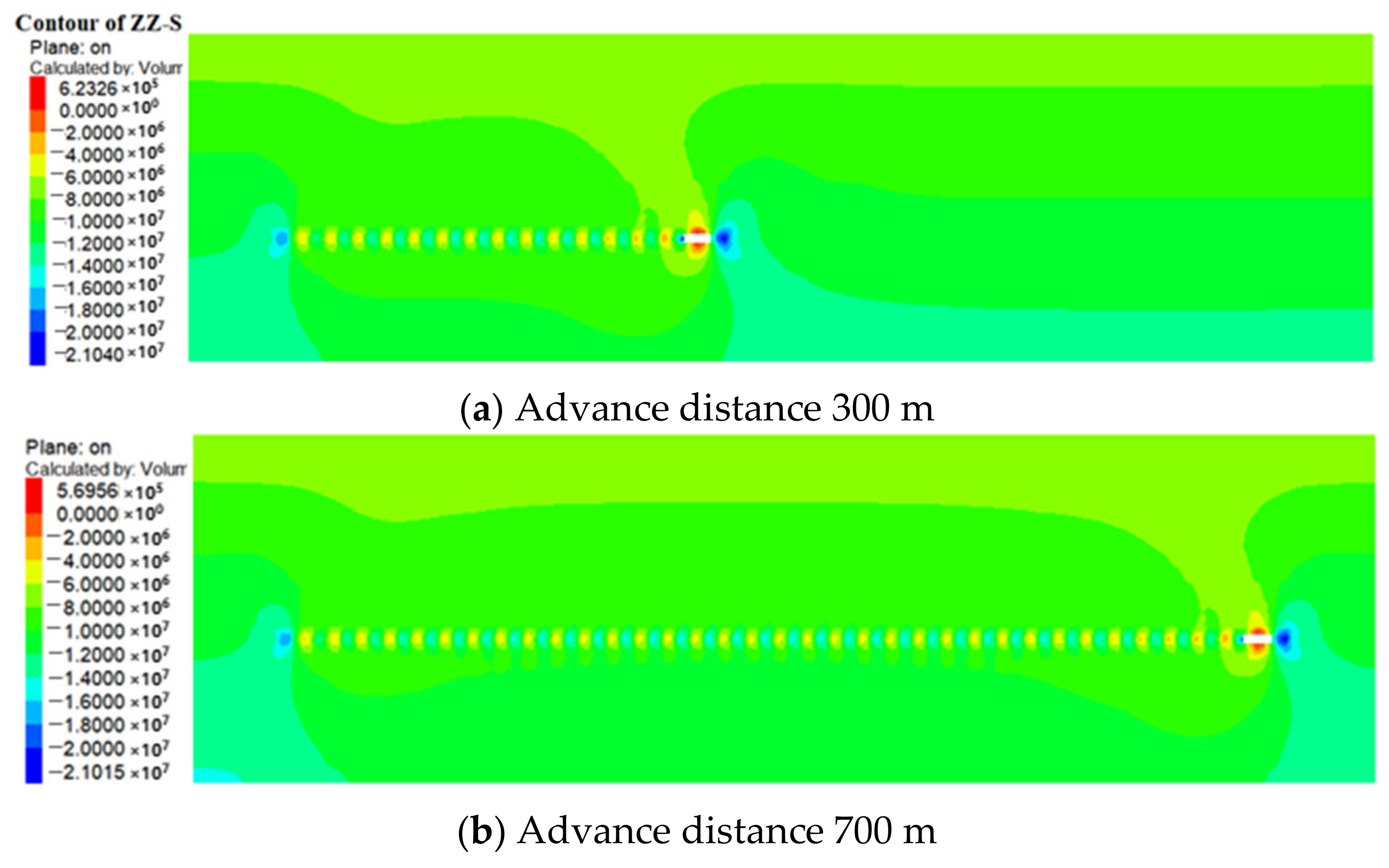

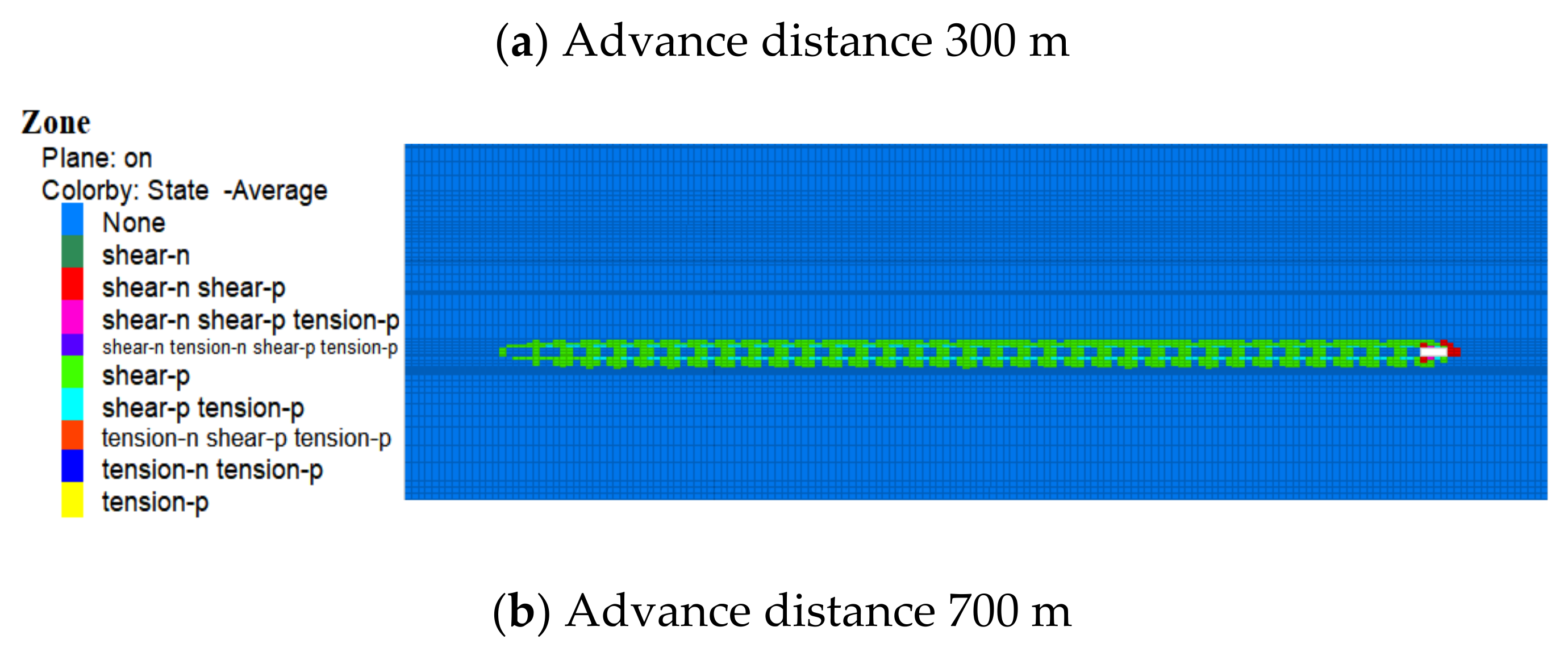
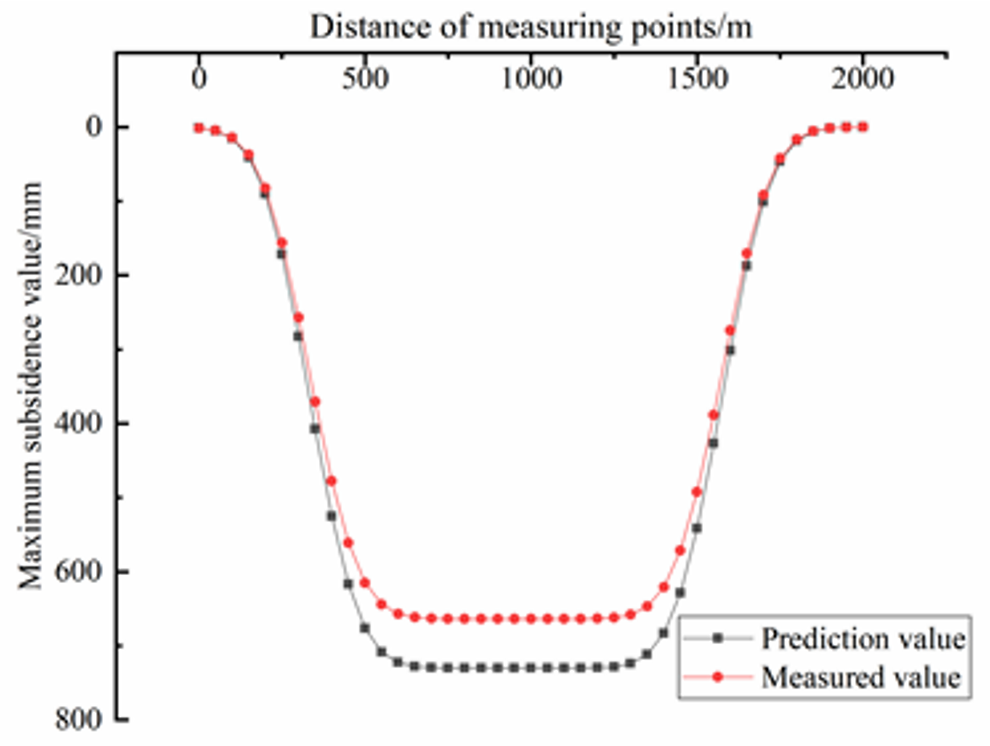
| Stratum | Thickness (m) | Density (kg/m3) | Bulk Modulus (GPa) | Shear Modulus (GPa) | Cohesive Force (MPa) | Frictional Angle (°) | Tensile Strength (MPa) |
|---|---|---|---|---|---|---|---|
| Siltstone | 4 | 2600 | 1.56 | 0.39 | 2.35 | 32.1 | 3.9 |
| Mudstone | 30 | 2600 | 3.1 | 0.9 | 2.5 | 40 | 4.2 |
| Siltstone | 11 | 2600 | 1.56 | 0.39 | 2.35 | 32.1 | 3.9 |
| Sandy mudstone | 11 | 2500 | 0.9 | 0.31 | 1.8 | 33 | 2.92 |
| Siltstone | 6 | 2600 | 1.56 | 0.39 | 2.35 | 32.1 | 3.9 |
| Sandy mudstone | 8 | 2500 | 0.9 | 0.31 | 1.8 | 33 | 2.92 |
| Post stone | 11 | 2600 | 1.52 | 0.3 | 2.3 | 35.1 | 2.92 |
| Sandy mudstone | 5 | 2500 | 0.9 | 0.31 | 1.8 | 33 | 2.92 |
| Siltstone | 18 | 2600 | 1.56 | 0.39 | 2.35 | 32.1 | 3.9 |
| Sandy mudstone | 3 | 2500 | 0.9 | 0.31 | 1.8 | 33 | 2.92 |
| medium sandstone | 31 | 2600 | 1.55 | 0.35 | 2.35 | 34 | 3.4 |
| Sandy mudstone | 6 | 2500 | 0.9 | 0.31 | 1.8 | 33 | 2.92 |
| 2-1#coal | 6 | 1500 | 1.5 | 0.4 | 2 | 15 | 0.8 |
| Siltstone | 7 | 2600 | 1.56 | 0.39 | 2.35 | 32.1 | 3.9 |
| Mudstone | 2 | 2600 | 3.1 | 0.9 | 2.5 | 40 | 4.2 |
| Post stone | 3 | 2600 | 1.52 | 0.3 | 2.3 | 35.1 | 2.92 |
| Medium sandstone | 13 | 2600 | 1.55 | 0.35 | 2.35 | 34 | 3.4 |
| Mudstone | 24 | 2600 | 3.1 | 0.9 | 2.5 | 40 | 4.2 |
| Siltstone | 11 | 2600 | 1.56 | 0.39 | 2.35 | 32.1 | 3.9 |
| Limestone | 40 | 2720 | 3.22 | 1.12 | 2.56 | 33 | 4.16 |
| Stratum | Thickness (m) | Density (kg/m3) | Bulk Modulus (GPa) | Shear Modulus (GPa) | Cohesive Force (MPa) | Frictional Angle (°) | Tensile Strength (MPa) |
|---|---|---|---|---|---|---|---|
| The clay | 117 | 2500 | 1.51 | 0.33 | 1.78 | 32.5 | 3.3 |
| Mudstone | 7 | 2600 | 3.1 | 0.9 | 2.5 | 40 | 4.2 |
| Post stone | 17 | 2600 | 1.52 | 0.3 | 2.3 | 35.1 | 2.92 |
| Mudstone | 9 | 2600 | 3.1 | 0.9 | 2.5 | 40 | 4.2 |
| Sandy mudstone | 24 | 2500 | 0.9 | 0.31 | 1.8 | 33 | 2.92 |
| Siltstone | 7 | 2600 | 1.56 | 0.39 | 2.35 | 32.1 | 3.9 |
| Sandy mudstone | 27 | 2500 | 0.9 | 0.31 | 1.8 | 33 | 2.92 |
| Medium sandstone | 10 | 2600 | 1.55 | 0.35 | 2.35 | 34 | 3.4 |
| Sandy mudstone | 24 | 2500 | 0.9 | 0.31 | 1.8 | 33 | 2.92 |
| Medium sandstone | 8 | 2600 | 1.55 | 0.35 | 2.35 | 34 | 3.4 |
| Siltstone | 8 | 2600 | 1.56 | 0.39 | 2.35 | 32.1 | 3.9 |
| Medium sandstone | 6 | 2600 | 1.55 | 0.35 | 2.35 | 34 | 3.4 |
| Sandy mudstone | 30 | 2500 | 0.9 | 0.31 | 1.8 | 33 | 2.92 |
| Siltstone | 4 | 2600 | 1.56 | 0.39 | 2.35 | 32.1 | 3.9 |
| Medium sandstone | 4 | 2600 | 1.55 | 0.35 | 2.35 | 34 | 3.4 |
| Sandy mudstone | 10 | 2500 | 0.9 | 0.31 | 1.8 | 33 | 2.92 |
| Siltstone | 5 | 2600 | 1.56 | 0.39 | 2.35 | 32.1 | 3.9 |
| Mudstone | 30 | 2600 | 3.1 | 0.9 | 2.5 | 40 | 4.2 |
| Siltstone | 11 | 2600 | 1.56 | 0.39 | 2.35 | 32.1 | 3.9 |
| Sandy mudstone | 11 | 2500 | 0.9 | 0.31 | 1.8 | 33 | 2.92 |
| Siltstone | 6 | 2600 | 1.56 | 0.39 | 2.35 | 32.1 | 3.9 |
| Sandy mudstone | 8 | 2500 | 0.9 | 0.31 | 1.8 | 33 | 2.92 |
| Post stone | 11 | 2600 | 1.52 | 0.3 | 2.3 | 35.1 | 2.92 |
| Sandy mudstone | 5 | 2500 | 0.9 | 0.31 | 1.8 | 33 | 2.92 |
| Siltstone | 18 | 2600 | 1.56 | 0.39 | 2.35 | 32.1 | 3.9 |
| Sandy mudstone | 3 | 2500 | 0.9 | 0.31 | 1.8 | 33 | 2.92 |
| Medium sandstone | 31 | 2600 | 1.55 | 0.35 | 2.35 | 34 | 3.4 |
| Sandy mudstone | 6 | 2500 | 0.9 | 0.31 | 1.8 | 33 | 2.92 |
| 2-1#coal | 6 | 1500 | 1.5 | 0.4 | 2 | 15 | 0.8 |
| Siltstone | 7 | 2600 | 1.56 | 0.39 | 2.35 | 32.1 | 3.9 |
| Maximum Subsidence Value (mm) | Maximum Dip Deformation (mm/m) | Maximum Horizontal Deformation (mm/m) | |
|---|---|---|---|
| Predicted value | 730 | 2.5 | 1.1 |
| Measured value | 608 | 2.1 | 0.9 |
Publisher’s Note: MDPI stays neutral with regard to jurisdictional claims in published maps and institutional affiliations. |
© 2022 by the authors. Licensee MDPI, Basel, Switzerland. This article is an open access article distributed under the terms and conditions of the Creative Commons Attribution (CC BY) license (https://creativecommons.org/licenses/by/4.0/).
Share and Cite
Wen, P.; Guo, W.; Tan, Y.; Bai, E.; Ma, Z.; Wu, D.; Yang, W. Paste Backfilling Longwall Mining Technology for Thick Coal Seam Extraction under Buildings and above Confined Aquifers: A Case Study. Minerals 2022, 12, 470. https://doi.org/10.3390/min12040470
Wen P, Guo W, Tan Y, Bai E, Ma Z, Wu D, Yang W. Paste Backfilling Longwall Mining Technology for Thick Coal Seam Extraction under Buildings and above Confined Aquifers: A Case Study. Minerals. 2022; 12(4):470. https://doi.org/10.3390/min12040470
Chicago/Turabian StyleWen, Peng, Wenbing Guo, Yi Tan, Erhu Bai, Zhibao Ma, Dongtao Wu, and Weiqiang Yang. 2022. "Paste Backfilling Longwall Mining Technology for Thick Coal Seam Extraction under Buildings and above Confined Aquifers: A Case Study" Minerals 12, no. 4: 470. https://doi.org/10.3390/min12040470






